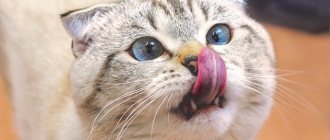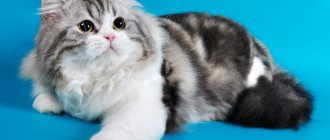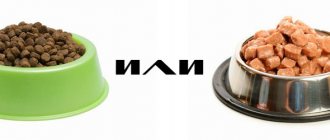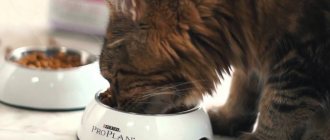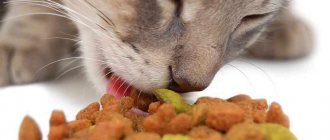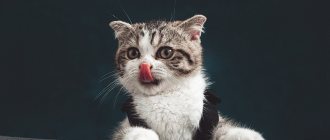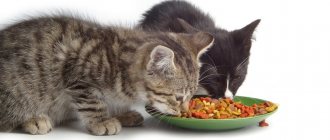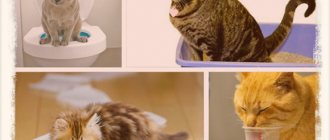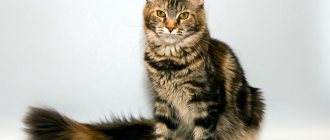Features of the cat's body
To understand how and what is best to feed your cat, you should know how its body works. First of all, it is important to understand that a cat is a born predator. Its jaws are designed in such a way that it tears its food. But this domestic animal does not have chewing teeth, and this is the key difference between a cat and omnivores.
Cats do not like cold food, because like any carnivorous animals, they are accustomed to eating their prey warm, immediately after being caught.
Cats are leisurely and quite picky eaters. Often, in the process of eating, an animal discards particles that it, for one reason or another, does not like. Knowing this, manufacturers use higher quality ingredients for cat food than for dogs.
For purring pets, the taste and smell of food is extremely important. For this reason, cat foods are more flavorful than dog food. In addition, cats are happy to try food with new tastes, so animals that refuse food should be offered food with a new taste. In most cases this works great.
Important! Cats, unlike other animals, do not distinguish sweet tastes. When choosing food for them, consistency, moisture and particle size are of greater importance.
Features of feeding adults and elderly animals
Aging of a cat’s body begins at the age of 7–8 years. At the same time, life processes slow down. The ability to absorb food decreases. Appetite may become worse or, on the contrary, intensify and cause overeating. The risk of metabolic disorders and intestinal motility increases. Externally, this is reflected in the condition of the pet’s skin and fur, and its well-being. A healthy diet helps reduce the effects of aging and improve your quality of life.
Dry food PRO PLAN® ORIGINAL ADULT is specially designed for adult cats over 7 years old. It contains a prebiotic to normalize peristalsis and intestinal microflora. Taurine and vitamin E act as an antioxidant and support the cat's visual acuity and immunity. The high content of protein and beneficial minerals maintains healthy joints, bones and teeth. The food slows down the aging process and prolongs the life of the pet, maintaining its activity.
During this period, it is especially important to monitor the animal’s body weight. A slower metabolism and decreased physical activity increases the risk of obesity. Interestingly, cats in old age - over 15-16 years old - cease to be obese and, rather, are underweight.
What type of diet to choose for a cat
You can feed your furry pet dry or wet food, or you can prepare natural food for your cat yourself. Each option has its own advantages and disadvantages. Let's study them.
Feeding with dry food
Today this is the most common type of nutrition. It has many obvious advantages, and first of all, this food is complete and balanced for the specific age and weight of your pet.
The food does not need to be prepared; you just need to pour the required amount of granules into a bowl and place water nearby so that the cat can drink. Unlike natural food, the granules will not spoil even if they lie in a bowl for two days, which is also an advantage of this type of food.
Important! Some owners have a prejudice against dry food. In their opinion, such food is harmful to the animal. Veterinarians respond to this that only economy-class food can harm a cat, while high-quality products meet all the needs of the cat’s body.
The only disadvantages of this approach to nutrition include the high cost of high-quality feed. In addition, given that dry food contains a minimum of liquid, it is important to ensure that the animal always has a bowl of clean water.
Natural food vs ready-made food
The most popular debate among cat owners is whether to feed their pet regular food or buy special food. In general, both “natural” and “drying” are suitable for any animal, but, as usual, there are nuances.
Natural food
It would seem that everything is clear with “natural food”: this is the customary name for any food that is not industrially produced. However, it is natural for a cat to eat freshly caught mice, small birds, and, as a dessert, herbs and grains. “Natural food” in the form of leftovers from the human table is absolutely not suitable for an animal: they contain too much salt and spices, not enough moisture and essential vitamins. By the way, the popular “feeding” of milk can only harm your pet: many cats suffer from lactose intolerance.
By natural food, veterinarians understand food produced at home, which is as close as possible to the diet of a cat in the wild. This includes rabbit meat, raw frozen red meat, poultry, offal, some sea (ocean) fish, boiled seafood, chopped cereals and vegetables. When eating natural foods, you should always add vitamins to your diet.
“Natural” food has its advantages: it looks and smells attractive, is good for dental health, and such food contains enough water.
However, there are also disadvantages: feeding is done strictly according to the clock, since such food quickly spoils, you need to add vitamins and minerals. Finally, this is a rather energy-intensive process for owners who need to cook not only for themselves, but also for their pet several times a day.
Industrial feed
There have been debates about industrial feeds since the beginning of their production. On the one hand, the advertising of Whiskas and Kitiket did its job and commercial cat food ceased to be a curiosity, on the other hand, it is precisely because of the cheap and not very balanced food that “drying” is considered unhealthy for animals. In reality, the world of industrial feed is very large and is not limited to bags of inexpensive food from the nearest supermarket.
We understand the types of industrial feed, their advantages and disadvantages.
Dry food
By dry food, manufacturers, veterinarians and buyers understand food made from meat, meat-bone and grain meal produced by extrusion. In factories, meat, bones, offal and grain are ground with a kind of industrial meat grinder, turning it into a homogeneous mass, shaped and dried, removing moisture so that the food can be stored for a long time. It is impossible to make such food from pure meat: in order for the ingredients to “bind” with each other, you need carbohydrates - corn, wheat, rice, barley flour, potato starch or legumes.
There are many myths about “drying”. They say that it provokes urolithiasis and allergies, such food spoils the fur (and character!), and the animals themselves may not like crackers. Some of this is true. For example, not all cats like this food, however, this often happens out of habit, and the pet just needs to get used to the unusual taste and smell.
But the rumors about urolithiasis are partly true. Evolutionarily, cats get enough water from natural food, but there is no moisture in dry food, so at home the animal will have to literally drink more. Make sure there is always free access to water. If a cat eats “crackers”, but also gets enough fluid, urolithiasis will not develop. If she does not like to drink water, it is better to switch her to a different diet.
The advantages of dry food: it is cheaper than natural food, more convenient in form, and does not require the introduction of additional vitamins and microelements. Owners do not need to strictly adhere to the feeding regime.
Cons: contains little moisture and may not be liked by the animal. In addition, in the case of inexpensive feeds, it is difficult to determine the specific composition of the product.
Wet food
They are canned food. In short, it is a balanced and vitamin-filled “natural drink” in a jar or plastic bag. In short, this is really real rabbit, lamb, salmon, chicken and other foods loved by cats, which are prepared in factories with the addition of preservatives.
Canned food is healthier than dry food, precisely due to the added moisture, which allows owners not to worry that the cat may develop urolithiasis.
There are several types of wet food depending on the form: mousse (heavily ground food, usually intended for kittens), pate, minced or minced meat in jelly, and stew (pieces of meat in jelly or sauce, often with the addition of vegetables).
There are two categories of wet food: complete food with a balanced composition that satisfies all the needs of an animal of a certain age, and complementary food, also known as a “treat.” The latter has an inferior composition and can be used as a reward or for medicinal purposes - as an addition to the main diet.
Pros: convenient, safe, you can take it with you, unlike heavy, large bags with “drying”. The food has already been balanced by the manufacturer; microelements and vitamins necessary for animals have been added to the feed. Cats love canned food because it looks appetizing to them.
Cons: not a budget option.
#BANNER#
Raw natural food
Quite a new type of cat food. By and large, this is still the same natural product: fresh meat, offal, quail or chicken eggs and vegetables already cut into pieces, with the addition of taurine, omega-3 acids and vitamins. The food is not heat treated: all ingredients are chopped and quickly frozen in individual bags. This food can be stored in a freezer at a temperature of –18 for up to six months, and after defrosting it can be stored in the refrigerator for 24 hours.
Pros: the most suitable diet for cats with a lot of nutrients. No preservatives or flavor enhancers are used in production.
Cons: price, inconvenient storage, need for freezing. In addition, such food is quite rare on sale and, as a rule, is distributed only in large cities.
Medical rulers
Medicinal (or veterinary) cat foods are not medicines, although they help improve the animal’s condition. Their therapeutic effect is primarily due to a reduced or increased content of certain substances (minerals, amino acids, prebiotics, etc.). Extracts of medicinal herbs are also added to such foods.
There are special low-calorie, high-fiber foods for overweight cats. Thanks to the presence of fiber, the pet quickly gets full and stops begging for a snack between feedings.
Hypoallergenic cat food does not contain the most allergenic types of protein - chicken, fish, eggs and seafood. Made from lamb, veal, rabbit, duck, turkey, salmon, herring, tuna. Although only a veterinarian can identify an allergy, most often its signs are deterioration in the appearance of fur and skin, itching, dermatitis, diarrhea, vomiting, and general weakness.
Special food: for newborn cats, older cats, kittens, etc.
Special feeds are produced on the same principle as medicinal ones, adding the necessary substances. Foods for pregnant and lactating cats contain more fat, which supports the animal's body during pregnancy and milk production.
Food for sterilized cats can be considered both regular and special food with a large amount of fiber and a minimum amount of fat, since sterilized animals are prone to weight gain.
Manufacturers add more proteins to kitten food, as well as calcium, magnesium, phosphorus, zinc and iron, which are responsible for healthy bones and teeth.
Most often, good food for older cats is produced in the form of canned food, since animals older than 8–10 years begin to have dental problems and cannot cope with hard “drying” granules. Such foods contain less protein than regular ones, so as not to overload the animal’s kidneys. It is not necessary to switch cats to “senior” food as they age, since their health largely depends on genetics and general condition. Often cats even older than 10–12 years have good digestion and excellent dental condition.
Natural cat food
Before choosing a diet, it is worth considering natural products and their effect on the cat’s body.
Meat and offal
This is the basis of your pet's diet. This includes the following products:
- lean beef (3-4 times a week);
- rabbit and lamb (allowed up to 2 times a week);
- turkey and chicken (if you are not allergic to chicken meat, they can replace half of the animal’s meat diet);
- offal (liver, heart, kidneys) is acceptable a couple of times a week.
Important! It is better to give chicken meat to a cat without the skin, which contains too much fat.
Remember also that meat products for your cat must first be frozen to eliminate parasites. Immediately before cooking, meat products are defrosted, brought to room temperature and only then given to the cat.
But pork, due to its high fat content, is not suitable for feeding cats. Such meat is difficult for the cat's body to digest.
Fish
Associatively, fish is considered the main diet of cats, however, in practice this is not so. Still, the main product of a cat, as a predator, is meat, and it cannot be completely replaced with fish.
Most cats love fish, but it should not be the mainstay of their diet.
In practice, it is better to give your cat ocean or sea fish 3-4 times a week. Typically, defrosted fish is given with bones, because this is good for your pet’s health.
Important! If you boil fish, the bones should be removed before feeding. The fact is that after boiling, the bones are easily separated from the meat, which means that the cat runs the risk of swallowing them.
Vegetables
In fact, vegetables do not play a key role in cat nutrition. However, they contain vitamins and minerals necessary for the normal functioning of the gastrointestinal tract. Therefore, when preparing food for your cat, try to add to it:
- cucumbers;
- zucchini:
- pumpkin;
- salad;
- cabbage;
- carrot.
Cats often love to crunch cucumbers
. Important! Representatives of the cat family are not suitable for fried, smoked or baked foods. You can boil food for your pet or serve it raw.
Dairy products
Considering that the intake of animal protein is extremely important for a cat, its diet must include dairy products, including:
- low-fat sour cream;
- cottage cheese;
- fermented baked milk;
- kefir;
- yogurt.
Important! Natural milk should not be given to cats. The fact is that the body of representatives of the cat family does not produce a special enzyme necessary for the breakdown of lactose.
Let us only add that the listed fermented milk products can be present in the diet as additional food, but they cannot serve as the basis of the diet.
Other food
Among other products that can also diversify your pet’s diet, we highlight cereal porridges, in particular, buckwheat and rice. However, such food often cannot be given, because grains are rich in carbohydrates, which can cause weight gain in the animal or lead to the development of allergic reactions. To prevent this from happening, give your cat porridge 2-3 times a week.
The nuances of home feeding cats
Properly organized feeding of cats at home is based on the following basic principles:
- The pet’s body receives all the substances necessary for its development;
- To avoid overloading the digestive system, the frequency of feeding is regulated;
- Depending on the age of the pet, the necessary substances are taken into account, what can be digested, and what cannot be absorbed.
Important: Food from the owner’s table is harmful for the most beloved pet, since humans and cats belong to different biological species.
Before you get yourself a new cat friend, you need to find out in advance how to properly feed it at home:
- Priority is given to natural or dry food from the first days. It is difficult for a cat's body to adapt from one species to another, so they do not mix.
- The need for nutrients changes as the pet ages, which means the diet for a kitten and an adult cat is different. The type of food also depends on the dental apparatus.
- A correctly selected dose will not leave the cat hungry, but will not cause overeating, and as a result, obesity.
- During a cat’s illness or pregnancy, the veterinarian regulates the balance of nutrients, as well as vitamins and minerals. The duration of feeding with special medicinal food is determined by a specialist.
- Dishes are kept clean. It is washed especially thoroughly after wet food. After all, leftovers become a haven for bacteria.
- To prevent your cat from being poisoned by natural or ready-made wet food, you need to learn how to properly feed wet food and its storage conditions. Food should not be on the plate for more than 1 hour. The food will be stale and spoiled.
- The lack of clean water in the drinking bowl will lead to a lack of fluid in the cat’s body, which will provoke urolithiasis.
What not to feed a cat
We have already mentioned above that many foods that people or dogs enjoy eating are not suitable for cats. Let's systematize this information. So, the following should not appear in the cat's bowl:
- table food - contains seasonings that can irritate the cat's stomach. Many sausages contain soy and fats, which are also harmful to the animal's digestion.
- fresh milk is not digested by the stomach and can easily cause indigestion;
- pork is too fatty a food that can cause a number of diseases;
- river fish and unprocessed meat - before giving the cat meat, it should be frozen, boiled, or at least doused with boiling water. This will protect your pet from helminth infection. As for river fish, it should also be boiled first and the bones removed;
- tubular and sharp bones (for example, chicken) - can injure the esophagus and lead to the death of the animal;
- coffee and alcoholic drinks are poisonous to cats.
Important! If a cat is diagnosed with obesity or diabetes, starchy and sweet foods should be immediately excluded from the diet. These animals require a low-carbohydrate diet.
Composition of cat food
What must be included
- Animal protein (at least 20–22%, ideally at least 35%): fresh or dried (dehydrated) poultry, beef, veal, rabbit, and in very rare cases, pork.
- By-products (at least 10%): liver, heart, etc. The exact ratio of by-products must be indicated on the packaging.
- Plant carbohydrates (minimal content): rice, barley, oats and legumes.
- Plant fiber (no more than 25%): herbs, vegetables, fruits. Carrots, zucchini, pumpkin, broccoli, asparagus, cucumbers, celery, beets, green beans, parsley, dill, lettuce, and sprouted grass are safe.
- Vitamins and minerals: taurine, vitamin B, E, unsaturated acids omega-3 and omega-6, calcium, potassium, amino acids.
- Rosemary extract as a natural preservative and antioxidant.
How many times a day should you feed your cat?
There is an opinion that your favorite “murka” needs to be fed at its first request, which it will communicate with an inviting look and a plaintive meow.
However, in reality, uncontrolled consumption of food by your pet will provoke excess weight gain, and can lead to heart pathologies, respiratory diseases, as well as problems with the gastrointestinal tract (constipation, volvulus and other dangerous conditions).
Feeding your little “beggar” from the table is no less dangerous. An extra piece of sausage or chicken is more likely to harm your pet than make it healthier. For this reason, a wise and caring owner should not follow the cat’s lead, but establish his own diet.
It has been experimentally proven that it is enough to feed your furry pet twice a day. It is two meals a day that are most beneficial for a cat’s digestion. At the same time, it is better to feed her in the morning and evening, about 30 minutes after the animal wakes up, and 1-2 hours before bedtime. And it is not so important whether it is dry food, canned food or natural food.
Important! Feeding your pet once, or more than twice a day, is not recommended. More frequent feeding of the cat (4-6 times) is allowed only in special cases, for example, during pregnancy, feeding kittens and certain diseases.
adjusting the diet in case of illness
When a pet gets sick, a properly formulated diet helps recovery and reduces the risk of exacerbation of a chronic process. And food of a specialized composition complements drug treatment (which is why dietary and therapeutic nutrition is prescribed by a veterinarian, taking into account the development of the disease and the condition of the animal).
In general, food for an animal weakened by disease must meet the following criteria:
- high-calorie;
- low-fat;
- easily digestible;
- “appetizing” (in the case of representatives of the cat family - fragrant).
Veterinary lines of ready-made food from brands such as Pro Plan, Royal Canin, Hill's, Sanabelle, Eukanuba... already contain diets for various diseases. But remember that you should purchase dietary and medicinal food only in specialized stores and veterinary pharmacies.
For naturally fed cats, the diet is prepared according to the type of disease:
anemia
The main task: to increase hemoglobin levels, restore acid-base balance, and supply tissues with oxygen.
The diet includes the following elements:
- complete proteins (in turkey, chicken, beef, cottage cheese);
- iron, copper, cobalt (in vegetables);
- bacteria beneficial for digestion and B vitamins (in fermented milk products);
- vitamins of group D (in fish);
- chlorophyll, which helps produce oxygenated blood (in fresh or dried greens).
CRF (chronic renal failure), nephritis and other kidney diseases
The main task: to maintain kidney function, reduce the risk of complications and exacerbations in chronic renal failure.
With kidney disease in cats, appetite is impaired, so special importance is attached to the taste and aromatic qualities of food.
The diet consists of the following products:
- rabbit, beef, chicken (raw meat and heart, in the form of minced meat); 2 times a week – liver;
- chopped oatmeal/buckwheat/rice cereal cooked in water without salt;
- boiled vegetables (lettuce, beets, broccoli, pumpkin, zucchini, cauliflower).
The intake of phosphorus and protein into the body is limited. Dairy products are contraindicated.
Drinking should be plentiful and freely available.
urolithiasis, cystitis
The main task: to reduce the acidity of urine, promote the dissolution of stones, and reduce the possibility of their re-formation.
In case of urolithiasis, laboratory tests are very important to determine the type of stones - dietary adjustments depend on this.
In general terms, nutrition for urolithiasis and cystitis (as its initial stage) is as follows:
- foods containing large quantities of vitamin C are excluded (as it promotes the formation of stones);
- increased amount of vitamins A and group B;
- the protein content is normalized (covers the animal’s needs, but does not exceed them, since excess protein quickly precipitates).
Exclude from the diet: canned food, sausages, smoked meats, pork, delicacies, salt, sugar.
Recommended products: boiled lean beef, veal, lamb, fish, chicken, weak fish/meat broths, beets, carrots, cauliflower, legumes, rice, rolled oats.
Boiling and filtering drinking water helps prevent excess mineral salts from entering the cat's body (it should always be clean and in sufficient volume - drinking plenty of water reduces the concentration and density of urine).
liver diseases, pancreatitis
The main task : to help reduce the load on the liver, pancreas and preserve their functions in the event of malfunction and the development of pathology.
After therapeutic fasting, the duration of which depends on the condition of the cat, the following products are gradually included in the diet:
- 1-2 days – ground oatmeal, buckwheat, rice in the form of liquid mucous porridges in water;
- Day 3 – steamed egg white omelet (without yolk);
- Day 4 – low-fat and non-acidic cottage cheese, fresh yogurt;
- Day 5 – rabbit, lamb, chicken, turkey, fish in the form of puree or soufflé;
- Day 6 – stewed/boiled zucchini and carrots.
By-products are completely excluded from the menu. Feeding is done in small portions, but at short intervals (from 2 to 4 hours).
colitis, constipation
The main task : remove toxins, relieve swelling, pain, spasms, restore water-salt and electrolyte balance in the body, normalize intestinal function.
On the first day, a fasting diet with plenty of fluids is prescribed.
Then the following components are gradually added to the diet:
- containing vitamins A, E, B;
- with probiotics that restore beneficial microflora in the intestines;
- smecta with enveloping properties to eliminate diarrhea, bloating, and general discomfort;
- bran, pumpkin, cellulose containing indigestible fiber - to improve peristalsis and intestinal motility.
The introduction of raw liver and foods saturated with fat into the diet helps stimulate intestinal motility and the digestive process, and plays the role of a mild laxative.
poisoning
The main task : to stabilize the general physical condition, remove the remnants of the toxic substance from the body.
After identifying the causes of poisoning and providing first veterinary aid to the animal, a 12-hour starvation diet is indicated.
Clean drinking water prevents dehydration of the body and removes from it the substance that causes intoxication and is absorbed into the blood.
How many times a day should you feed a kitten?
With kittens it's a little different. As a rule, newborn kittens are fed by the mother cat, and the owner can only feed the parent in a timely manner. If for some reason you get a single newborn kitten, you need to feed it with a cat's milk replacer, giving a small portion from a pipette every 2 hours. Moreover, this regime must be observed even at night.
Important! Veterinarians do not recommend adopting a kitten under one month old, precisely because of the difficulty with feeding. If possible, the mother cat should feed the kitten for the first month of its life.
An older kitten (2-3 months) needs to be fed every 5-6 hours, continuing to give milk, but introducing vegetables, cereals and chopped meat into the diet and food of adult cats.
When the pet reaches this age, it can be switched to three meals a day (morning, afternoon and evening), and from 8 months onwards it can be switched to feeding twice a day (morning and evening). True, some owners continue to feed their household three times a day for up to a year.
What you need to know when you get a kitten
Little kittens definitely need proper nutrition, as their growing bodies require all the necessary vitamins and components. What to feed a kitten? Experts recommend the following foods for feeding:
- Little by little, boiled, finely chopped dietary meat should be introduced into the diet.
- Frozen raw beef (but boiled is better).
- Porridge cooked with milk.
- Both raw and boiled vegetables.
- Yolk.
- 0% fermented milk products.
- Cereals.
- There should always be drinking water in a separate bowl.
It is worth noting that only an experienced veterinarian after examining him can give precise recommendations on the proper feeding of your four-legged friend.
Feeding with prepared dry and wet food is allowed. If owners prefer this option, then they should not choose cheap options; preference should be given to premium and super-premium classes of feed. The best option for feeding a kitten is holistic food for cats, as they are endowed with all the necessary vitamins and beneficial microelements.
How many times a day should you feed your cat? The correct feeding regime is very important for a growing organism:
- A two-month-old kitten needs to be given food about 6 times a day.
- When the fluffy ball turns 6 months old, feeding should be reduced to 3 times.
- At 8 months, the kitten should be gradually transferred to the diet of adult cats, which includes feeding twice a day.
How often to feed a spayed or neutered male cat
Animals that have undergone sterilization or castration have changes in their feeding behavior. Due to hormonal changes, they develop an increased appetite, against which they constantly beg for food and rapidly gain weight.
Neutered animals may be prone to obesity
Owners should reconsider the diet of such pets. The ideal option in this case would be low-calorie dry food (for example, Royal Canin Regular Sterilized or Hills Sterilized). If you feed your cat natural food, remove fatty meat, spicy and smoked foods from the animal’s diet, replacing them with plant products, as well as lean meat and fish.
Important! To prevent your pet from looking into your plate and meowing pitifully, distracting you from eating, you first need to feed the cat, and only then eat the meal yourself. This will make both of you more comfortable.
What to feed a cat
The cat's body needs water, just like the human body. But the need for it is much less. The modern domestic cat descended from wild cats - inhabitants of the steppe, desert and partly mountainous regions of Africa. Their body has adapted to save moisture and make do with a small amount of fluid coming from outside. In addition, cats receive some of their moisture through food. Be sure to provide a bowl of water for your pet and keep its contents clean and fresh. Renew the supply and thoroughly wash the container at least once a day.
Use drinking water. If the tap water in your region is of poor quality and you don’t drink it yourself, don’t give it to your cat either. If you use bottled water for drinking and cooking, let your cat drink the same. High salt content causes urolithiasis; you should not give your animal mineral water. The ideal option is soft natural water. You can also use filtered water at room temperature.
Proper nutrition keeps your cat healthy and ensures a high quality of life. With PRO PLAN® food you can easily create a diet for your pet, taking into account its needs and characteristics.
What to do if you have to leave your pet alone for a long time
There are times when you are forced to leave your cat alone at home for 12 hours, or even a day. What to do with food in this case?
Most owners solve this problem simply by leaving a handful of dry food in her bowl. However, this method is not suitable for those pets that eat natural food. In this case, the owners put not one, but two servings in the bowl. This will allow your pet not to suffer from a long break in feeding.
Combined nutrition
A combination of wet and dry food in the diet helps add variety to the diet and increase appetite. This is especially important for adults and older animals. Wet food saturates the body with the necessary fluid, while dry food increases appetite, because it is so pleasant to chew on. In addition, chewing dense granules helps cleanse your cat’s teeth of plaque. The combination of the two types of food helps maintain the health of the digestive and urinary systems.
Both types of food should be given in small portions to prevent the animal from overeating. Offer dry and wet diets at different feeding times; do not mix the two types of food in the same bowl. Don't forget to control the size of your daily food portion: when adding wet food, reduce the amount of dry food. Make sure that the food does not spoil or dry out: what is left uneaten must be removed.
Is it possible to give a cat dog food?
The digestion of cats and dogs is quite different, both in the length of the esophagus and in the enzymes produced to digest food. Therefore, dry dog food has significant differences from cat food. So, for example, in them:
- reduced protein content;
- high carbohydrate content and very little fat;
- low vitamin A content;
- Taurine, which is important for the cat’s body, is missing;
- high content of plant substances that the cat’s body cannot absorb.
Additionally, due to the size difference, dog food kibble is noticeably larger than dry cat food. And this feature can lead to dental problems and poor digestion of food.
It can be said that a one-time snack of dog food will not harm your cat. If the need arises, let it be puppy food. However, feeding your cat such food all the time is prohibited! This will inevitably lead to gastrointestinal diseases.
Choosing the right food is important
Let's start with biology. Any cat – from the cute gray Murka, who has never gone outside even once in her life, to the brutal yard “Siberian” with the expression “robbing, killing, burning cities” on her expressive face – is a carnivore. If canids (dogs, foxes, jackals and even wolves) are omnivores and, under certain circumstances, can eat plant foods, then cats, due to the characteristics of the digestive tract, are obligate predators - that is, unable to survive without meat. Plant foods do not contain the amino acids necessary for felines, in particular taurine, the absence of which causes weakened vision and even blindness in animals. In addition to taurine, there are several other vital substances for cats that are found only in food of animal origin: arachidonic acid, vitamin A, vitamin B12 and niacin.
Just like humans, cats can have health problems due to age, poor diet, or genetic predispositions. For such animals, food is selected individually to provide the animal with the necessary vitamins and microelements. But even for the average Murka, the food must be balanced and completely suitable for her age, breed (yes, everything is complicated, cats of different breeds also have different food requirements) and lifestyle.
Drinking regime for cats
We must not forget about the water regime. This is important for all cats, without exception, but especially for those that eat dry food, because they simply have no other sources of replenishing their fluid reserves!
Without water, your pet's health can suffer serious complications. Therefore, make sure that next to your pet’s food bowl there is a drinking bowl with clean water (preferably filtered water).
Keep in mind that cats love fresh water, and therefore it needs to be changed daily, not forgetting to wash the container, on the walls of which mucus may form. In addition, it is desirable that the water be soft and low in minerals. This will protect your animal from the development of urolithiasis.
By the way, pay attention to the material from which the drinker is made. A cat may refuse to drink from a plastic container because... plastic absorbs and retains unpleasant odors. The best option would be a drinking bowl made of glass or porcelain.
age
When taking the “baby” home, you need to know all the nuances of the baby’s nutrition (the main thing is do not overfeed the kitten, he is only reflexively “eternally hungry”):
- Up to a month, kittens “torn off the tit” can be fed 5-6 times a day with a mixture of 4 parts milk and 1 part egg white (mixed thoroughly).
- in the second month, you can start feeding baby meat purees 4-5 times a day (it contains the required amount of protein and vitamins), slightly diluting the diet with grated vegetables and cottage cheese.
- By the third month, you need to switch to dry food or solid food - this is necessary for the proper formation of teeth.
- from five months, kittens can already be fed “adult food” 3-4 times a day, making allowances for the size of the pieces/pellets and taking into account that the growing body needs more nutrition (relative to the “weight coefficient”).
It is under no circumstances recommended to give kittens all kinds of “goodies” (sausages, smoked meats, etc.) - they contain a lot of “chemicals” and additives that are frankly harmful to cats.
Foods high in fat are also not recommended.
If you decide to feed your kitten with ready-made food, everything is much simpler: choose a bag with the required age category and follow the manufacturer’s instructions (the only thing is that if you value your pet’s health, try not to feed your kitten with economy class food).
If you want to prolong its stay with you, the diet of an elderly animal must be selected purely individually.
The “beginning of aging” in cats largely depends on the breed and quality of life (not least of all nutrition); for the “average cat in favorable conditions” this is the age of seven years.
Things to consider:
- firstly, older animals digest fats worse - they need food especially rich in protein and very low in fat
- With aging, the consequences of vitamin-mineral imbalance are more pronounced - this should be monitored and appropriate adjustments made in the pet’s diet (for example, if there is a lack of calcium, the cat will have problems with the cardiovascular system, and if there is an excess, with the urinary system and joints).
- to avoid constipation, make sure that your pet consumes a large amount of liquid (the water should be not only fresh, but also warm, because cold water causes discomfort to the mucous membranes of cats).
- if appetite worsens, you need to check your pet for problems in the oral cavity (if there are no problems: warm the food to room temperature, and soften the dry food or replace it with wet food).
- if excessive appetite occurs, you should increase feeding frequency, but reduce portions (obesity is the worst enemy in old age).
When feeding an elderly but relatively healthy cat with “store-bought food”, it is enough to take into account only the “marks on the package”, but if your pet has health problems, it is better to consult a veterinarian.
Feeding factory wet food
If you are against dry food, you can stick to wet food. But things are not so simple here.
Not all wet canned foods are complete, which means that their composition is not completely balanced.
Many canned cat foods indicate that the product is a supplementary food. That is, it is used for mixed feeding.
This type of feeding has disadvantages, the most important of which are:
- High cost of wet food. One pouch of such food or canned packaging of the product will cost at least 70 rubles, and more often even more expensive. If you feed this food constantly, keeping a cat will cost a pretty penny. Of course, we are talking about high-quality food, and not mass-market food for 15 rubles apiece.
- In addition, such food will not always be complete. You need to pay attention to the manufacturers, composition and information on the packaging.
How to properly transition a kitten to adult food
In the first year of life, the kitten grows and develops. When he turns 8-9 months old, not only his appearance changes, but also his needs. During this period, the baby becomes an adult and no longer needs the same nutrition. Now his body requires a balanced diet containing moderate amounts of protein and fat.
If you do not provide your cat with proper nutrition during this period of its life, it may become overweight and there is also a risk of problems with the musculoskeletal system.
